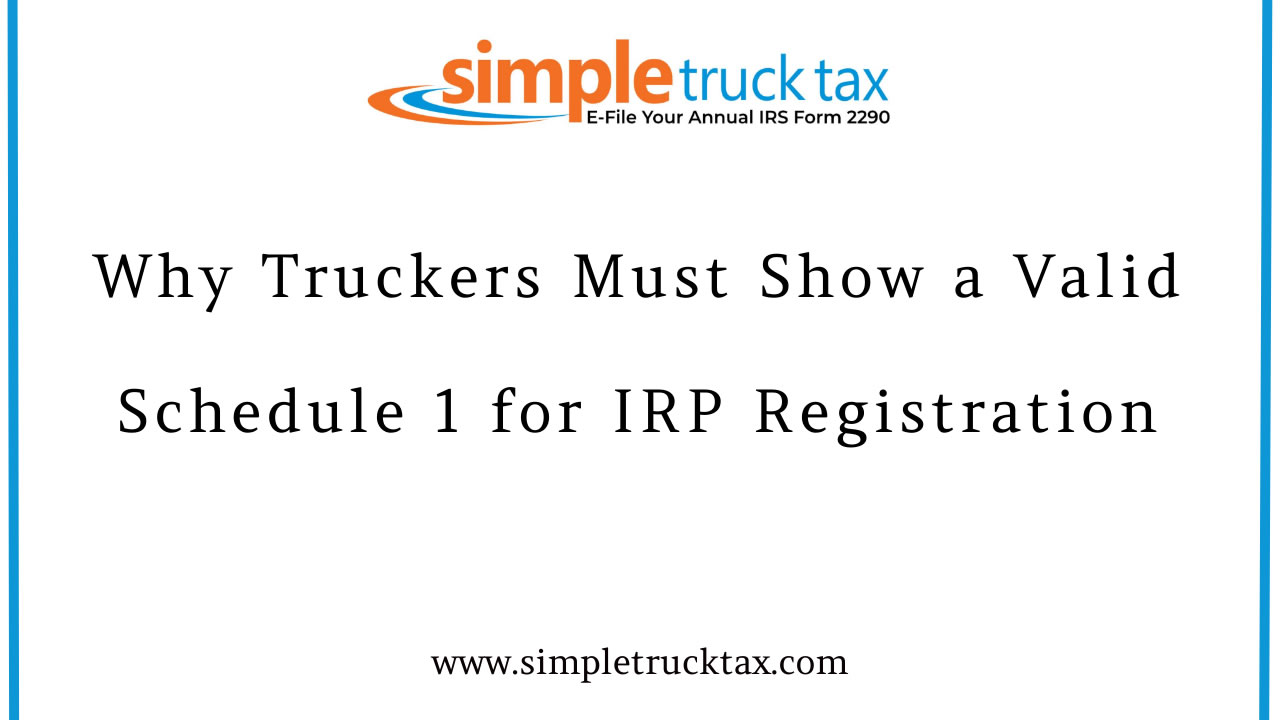
Why Truckers Must Show a Valid Schedule 1 for IRP Registration
If you are renewing or applying for apportioned international registration plan (IRP) plates, one document that you will need to have is your IRS Form 2290 Schedule 1. And IRP offices throughout the U.S. won't complete your registration until a valid Schedule 1 is on file. This applies whether you're an owner-operator with one truck or a fleet owner with dozens all across the United States.
This is one of those requirements that surprises a lot of new truckers, but it really means a lot in keeping you and your operation compliant with federal and state regulations. Here are all of those facts you need to know.
What is Form 2290 Schedule 1?
This is a tax form of the IRS that pays the Heavy Vehicle Use Tax (HVUT) accrued by the trucks weighing 55,000 pounds and above.
When one files IRS Form 2290 and thus pays the HVUT, the IRS returns Schedule 1, which acts as proof that the tax is actually deposited for the vehicle.
Such Schedule 1 is the dependency of the IRP offices in issuing or renewing apportioned plates to the actor.
Why IRP Offices Require Your 2290 Schedule 1
No IRP office would want Schedule 1 except as documentation; it is a legal requirement that they obtain evidence of your HVUT payment. Below are major reasons:
A Federal Compliance Requirement
In fact, States are supposed to verify HVUT before registration or renewal of heavy commercial vehicles, according to federal law.
So, if you don't have Schedule 1, the IRP offices will just tell you no.
Making Sure You're Not Operating Vehicles That Are Tax-Delinquent
The core idea of Form 2290 is funding highway maintenance and infrastructure.
By requiring Schedule 1, IRP offices ensure that all vehicles are operating legally and contributing to the funding of highways.
Helps Prevent Fraud and Un-Registered Fleets
Schedule 1 keeps checks on:
- The VIN belongs to the filing taxpayer
- Fleet properly accounted for
- No truck is registered without HVUT being paid
This covers both the state and honest truckers who comply with the rules.
What if you Attempt Renewing Your IRP Plates Without Schedule 1?
Your IRP application stands:
- Delayed, Or, Rejected altogether
Consequently, you experience operational problems that are severe, such as:
- Trucks taken off the road
- Missed loads
- Contract penalties
- Down-time that is expensive
To avoid these delays, always file your Form 2290 online to get your stamped Schedule 1 right away.
When do you File Form 2290 for IRP Purposes?
You should file Form 2290:
- Annually between July 1 and August 31, or
- Within the same month, the new truck goes on the road
- If the renewal month is approaching, file early to avoid last-minute issues at the IRP office.
How Online Filing Helps you Fast Track Your IRP
There are considerable advantages to e-Filing Form 2290:
- Two minutes delivery of Schedule 1
- Correction of VINs supported
- Confirmation of receipt immediately by e-mail
- Easy access to your Schedule 1, any time you might need it for future IRP, DMV, or insurance
Most IRP offices like electronically filed Schedule 1 because they are the ones who think they are accurate, will take their time to verify, and those approved by IRS.
Keep Copies of Your Schedule 1
Keep your Schedule 1 in:
- On your phone
- On your email
- In your compliance folder
- On the cloud
You never know when you might need quick access later for an IRP audit or update.
IRP offices require a valid Form 2290 Schedule 1 as that is the only official proof of HVUT payment and legality in operation. Timely filings do not just have compliance value; they also save your business from costly downtimes and delays in registration.